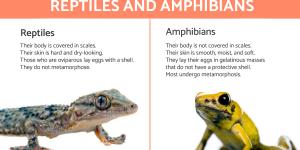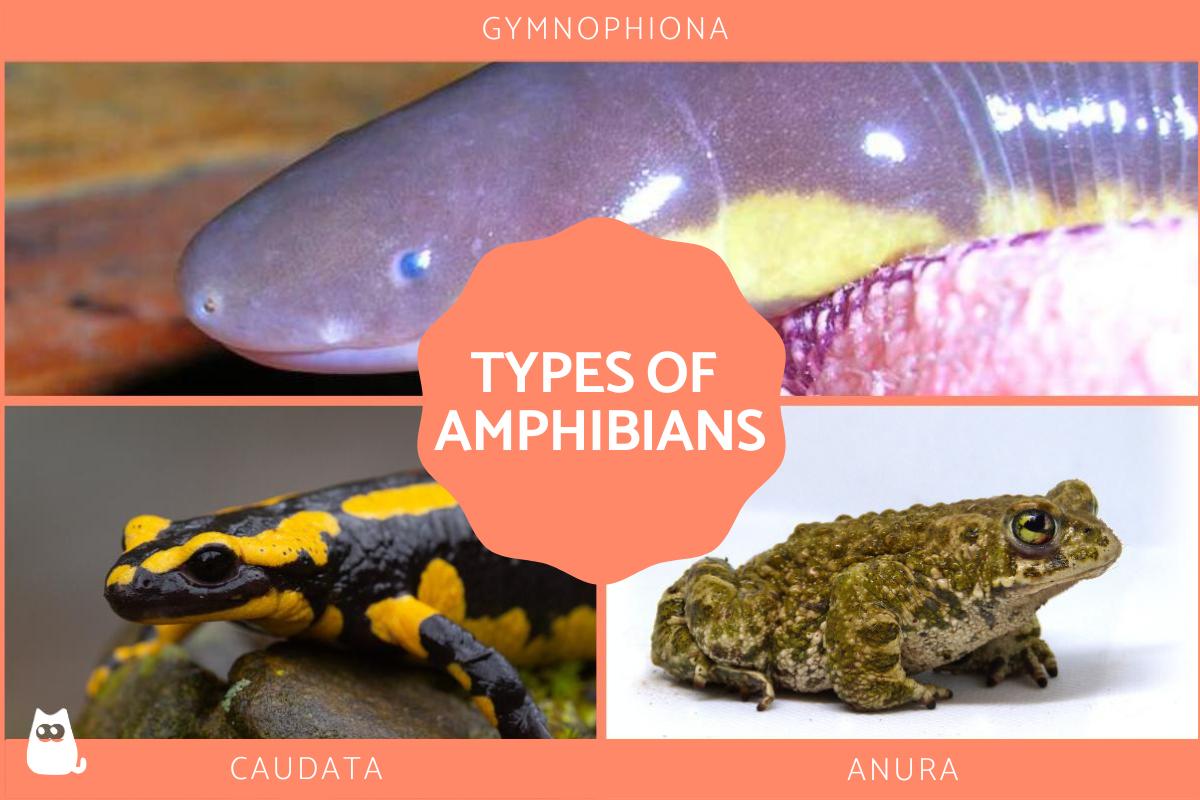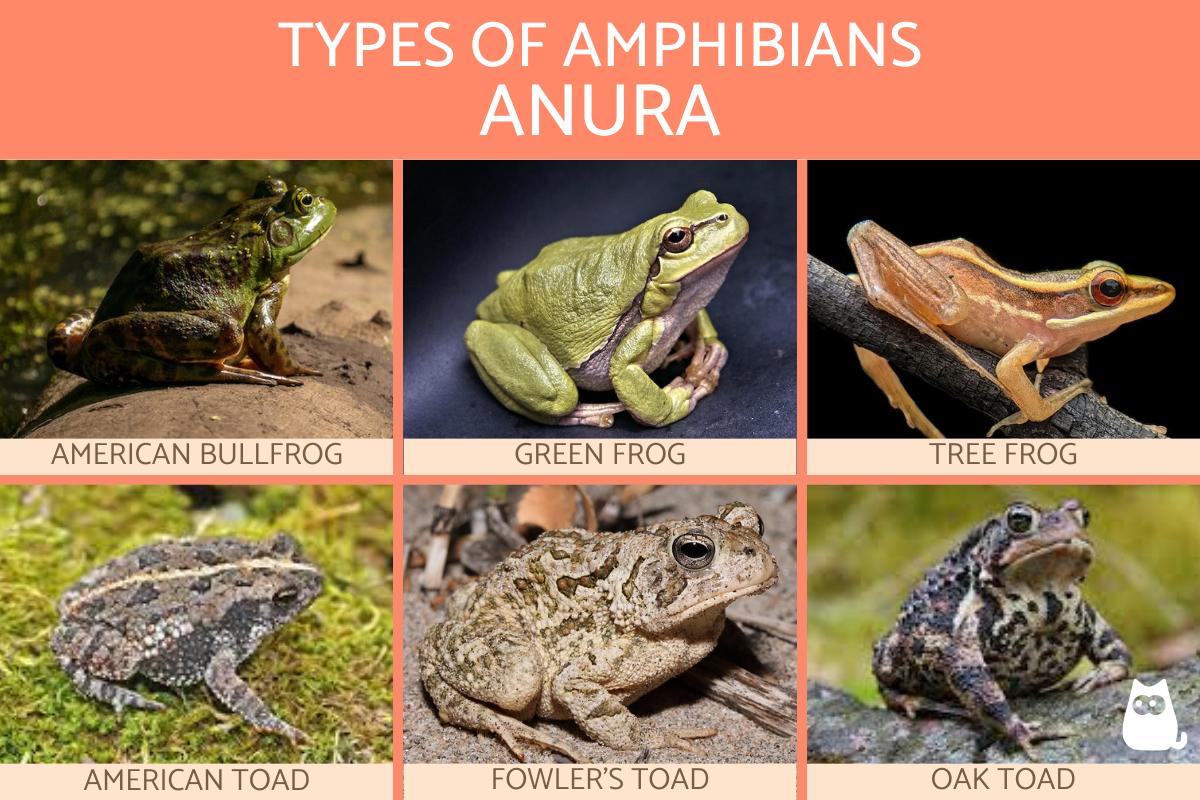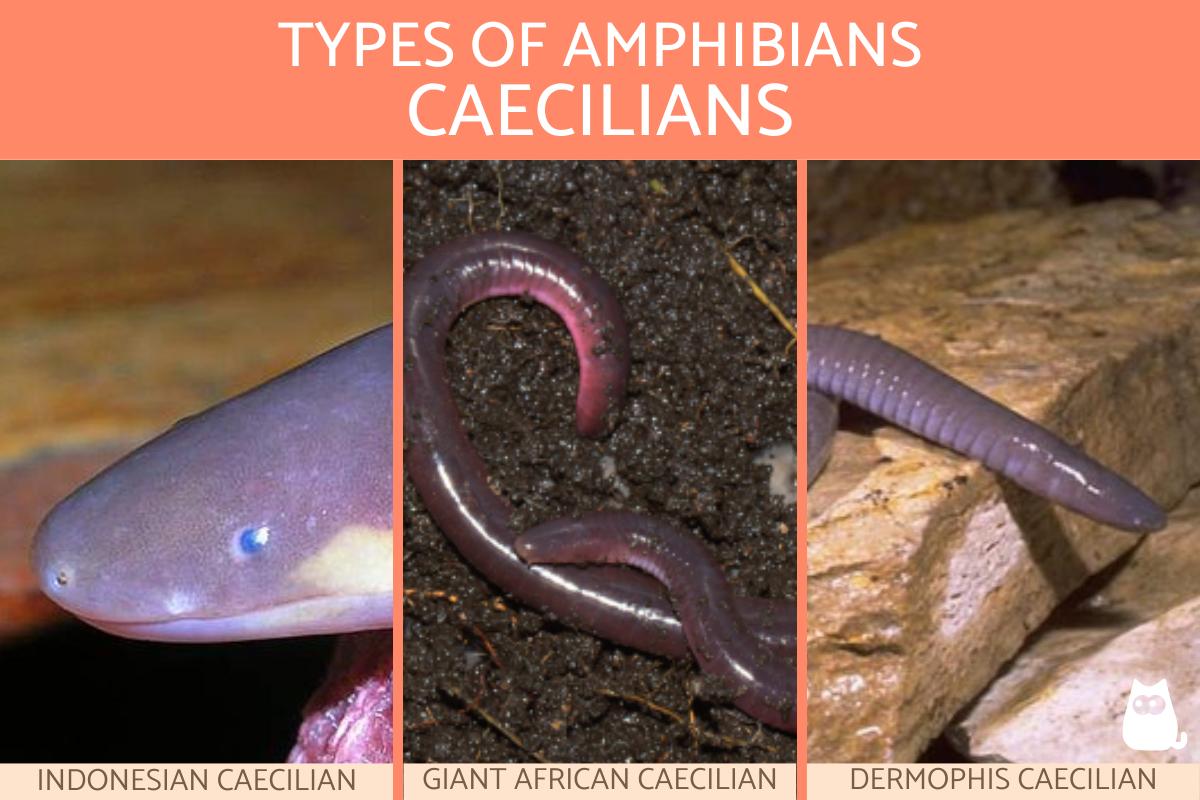Types of Amphibians


Amphibians, a diverse group of vertebrates, represent a fascinating transition from aquatic to terrestrial life. These remarkable creatures, classified within the class Amphibia, have adapted to both aquatic and terrestrial environments, undergoing a metamorphosis from gill-breathing larvae to air-breathing adults. Amphibians have graced our planet for over 350 million years, inhabiting a wide array of ecosystems, from lush rainforests to arid deserts. The amphibian world is incredibly diverse, with over 7,000 known species.
The following AnimalWised article explores the different types of amphibians, as well as their unique characteristics and adaptations.
What are amphibians?
Amphibians are a diverse group of cold-blooded vertebrates that belong to the class Amphibia. The amphibian world is a realm of remarkable diversity, encompassing over 7,000 known species. Amphibians are found in various habitats worldwide, from tropical rainforests to arid deserts, and play essential roles in ecosystem dynamics.
Amphibians trace their evolutionary origins to the Devonian period, approximately 370 million years ago. The transition from fish to amphibians marked a critical step in vertebrate evolution as organisms adapted to terrestrial environments.
Amphibians are classified as ectothermic or cold-blooded animals, meaning their body temperature fluctuates with the surrounding environment. Unlike warm-blooded animals that can regulate their internal temperature, amphibians rely on external sources of heat, such as the sun, to maintain their body temperature. This adaptation allows amphibians to thrive in a wide range of habitats, from cool temperate zones to tropical regions.
A defining characteristic of amphibians is their remarkable metamorphosis, transforming from aquatic larvae with gills and tails to air-breathing adults with lungs and limbs. Larvae, such as tadpoles, are typically adapted for an aquatic life, with gills for respiration and tails for swimming. As they mature, amphibians undergo a series of changes, developing lungs and limbs, and losing their tails to adapt to a terrestrial lifestyle.
Amphibian skin plays a crucial role in respiration, gas exchange, and water balance. Their skin is thin, permeable, and typically moist, allowing them to absorb oxygen and release carbon dioxide directly through their skin. This adaptation is particularly important for aquatic larvae and terrestrial amphibians that inhabit humid environments. Additionally, amphibian skin secretes mucus, which helps protect them from dehydration and pathogens.
Discover the intriguing adaptations, habitats, and ecological roles of reptiles and amphibians in our comprehensive guide.

Classification of amphibians
Amphibians are classified into three main orders:
Anura (frogs and toads)
Frogs and toads are the most familiar and diverse group of amphibians, characterized by their tailless bodies, long hind legs for jumping, and webbed feet for swimming. They typically undergo a complete metamorphosis, transforming from aquatic tadpoles to terrestrial adults.
Caudata (salamanders and newts)
Salamanders and newts are characterized by their elongated bodies, tails, and smooth, moist skin. Unlike frogs, they retain their tails throughout their lives. Some salamanders undergo a complete metamorphosis, while others retain aquatic larval features even as adults.
Gymnophiona (caecilians)
Caecilians are legless amphibians that resemble snakes, inhabiting tropical and subtropical regions. They have smooth, scaleless skin and lack eyes, relying on sensory organs for navigation. Caecilians undergo a direct metamorphosis, hatching as miniature adults.
Within these orders, amphibians are further divided into families, genera, and species, reflecting their remarkable diversity and adaptations. In the following sections, we will take a closer look at each of these orders.
Types of amphibians: Anura
Anurans, the most familiar and diverse group of amphibians, are characterized by their tailless bodies, long hind legs for jumping, and webbed feet for swimming. They typically undergo a complete metamorphosis, transforming from aquatic tadpoles to terrestrial adults. Anurans possess smooth, moist skin that aids in respiration and gas exchange, and they exhibit a wide range of vocalizations, using croaks, ribbits, and whistles to communicate and attract mates.
Communication within anuran communities is a captivating aspect of their behavior. These amphibians exhibit an extensive array of vocalizations, ranging from distinctive croaks and ribbits to melodic whistles.
Anurans are further divided into two main subcategories: frogs and toads. While these groups share many similarities, they also exhibit distinct characteristics that distinguish them.
Frogs
Frogs are typically characterized by their smooth, moist skin, long hind legs, and agile movements. They are often found near water sources, such as ponds, lakes, and streams. Examples of common frog species include:
- American bullfrog (Lithobates catesbeiana): the largest native frog in North America, known for its deep, resonant croaks.
- Green frog (Rana clamitans): a common North American frog with a bright green body and a loud, banjo-like call.
- Tree frog (Hylidae spp.): a diverse group of frogs that inhabit trees and other elevated surfaces, known for their adhesive toe pads and ability to change color.
Toads
Toads, on the other hand, are characterized by their warty, bumpy skin, shorter hind legs, and a more terrestrial lifestyle. They are often found in drier habitats, such as forests, grasslands, and gardens. Examples of common toad species include:
- American toad (Anaxyrus americanus): a common North American toad with warty skin, a distinctive cranial crest, and a loud, high-pitched call.
- Fowler's toad (Anaxyrus fowleri): A medium-sized toad with warty skin and prominent ridges on its back, found in eastern and central North America.
- Oak toad (Anaxyrus quercicus): A large toad with warty skin and a distinctive orange or yellow patch on its head, found in southeastern North America.
Discover the key characteristics that distinguish frogs from toads, gaining a confident eye for recognizing these remarkable creatures.

Types of amphibians: Caudata
Caudata, the order encompassing salamanders and newts, is distinguished by its members' elongated bodies, tails, and smooth, moist skin.
Unlike frogs, salamanders and newts retain their tails throughout their lives. Some salamanders undergo a complete metamorphosis, transforming from aquatic larvae with gills and tails to air-breathing adults with lungs and limbs. Others, like the mudpuppy, retain aquatic larval features even as adults.
Salamanders and newts share many similarities, but they also exhibit distinct characteristics that distinguish them.
Salamanders
Salamanders are typically terrestrial amphibians, inhabiting forests, grasslands, and even caves. They possess a wider range of body shapes and sizes compared to newts, with some species reaching over a foot in length. Examples of salamander species include:
- Tiger salamander (Ambystoma tigrinum): the largest terrestrial salamander in North America, known for its bold black and yellow markings.
- Red-backed salamander (Plethodon cinereus): a common woodland salamander with a distinctive red stripe along its back.
- Hellbender (Cryptobranchus alleganiensis): the largest aquatic salamander in North America, known for its wrinkled skin and external gills.
Newts
Newts are semi-aquatic amphibians, often found in ponds, lakes, and slow-moving streams. They typically have smoother, more aquatic-adapted bodies than salamanders, with streamlined tails and limbs adapted for swimming. Examples of newt species include the eastern newt, the red-spotted newt, and the smooth newt.
- Eastern newt (Notophthalmus viridescens): a common North American newt with a smooth, olive-green body and bright orange belly.
- Red-spotted newt (Notophthalmus erythrophethalmus): a smaller newt with a bright red body and black spots.
- Smooth newt (Triturus vulgaris): a Eurasian newt with a smooth, dark brown body and a yellow underside.
Explore the fascinating science behind the incredible toxicity of certain amphibians and their ecological significance.

Types of amphibians: Caecilians
Caecilians, the legless amphibians that resemble snakes, represent a fascinating and enigmatic group within the amphibian world. They are distinguished by their lack of limbs, smooth, scaleless skin, and reduced or absent eyes.
Caecilians are primarily fossorial, meaning they spend most of their lives underground, inhabiting tropical and subtropical regions.
Caecilians have evolved remarkable adaptations to their subterranean lifestyle. Their scaleless skin is highly permeable, allowing them to absorb moisture and oxygen directly from their environment. Their eyes are either reduced or absent, and they rely primarily on sensory organs, such as their tentacles and lateral line system, to navigate and detect prey.
Caecilians possess powerful muscles for digging and burrowing, and some species produce a sticky mucus that aids in locomotion and protection.
Caecilians exhibit a remarkable diversity of body forms and sizes, ranging from slender, worm-like species to robust, burrowing forms. Some notable examples include:
- Indonesian caecilian (Rhinophis rostratus): a small, slender caecilian with a light brown body and a long, pointed snout, found in Indonesia.
- Giant African caecilian (Scolecomorphus kirkii): the largest caecilian species, reaching up to 5 feet in length, found in Africa.
- Dermophis caecilian (Dermophis nigromarginatus): a colorful caecilian with a black body and yellow rings, found in Central and South America.
Read this other article to discover the true identity of worms and their fascinating connection to the amphibian world.

If you want to read similar articles to Types of Amphibians, we recommend you visit our Facts about the animal kingdom category.
- Arxold, E.N. & Burton, J.A. (1978). Field guide to the amphibians and reptiles of Spain and Europe . Omega Publishing. Barcelona.
- Hickman, CP et al (2009): Comprehensive principles of Zoology . McGraw-Hill, Madrid.
- Kupfer, A., Kramer, A., Himstedt, W., & Greven, H. (2006). Copulation and egg retention in an oviparous Caecilian (Amphibia: Gymnophiona) . Zoologischer Anzeiger-A Journal of Comparative Zoology, 244(3-4), 223-228.
- Lehtonen, A., Salonen, A., Cantell, H., Riuttanen, L., & MacMillan, P. IPBES [The Inter-Governmental Science-Policy Platform on Biodiversity and Eco-System Services] (2019). Media Release: Nature's Dangerous Decline 'Unprecedented' Species Extinction Rates 'Accelerating '. Available at: ipbes.net.
- Scheele, BC, Pasmans, F., Skerratt, L.F., Berger, L., Martel, A., Beukema, W... and De la Riva, I. (2019). Amphibian fungal panzootic causes catastrophic and ongoing loss of biodiversity . Science, 363(6434), 1459-1463.
- Xavier, F. (1977) . An exceptional reproductive strategy in Anura: Nectophrynoides occidentalis Angel (Bufonidae), an example of adaptation to terrestrial life by viviparity . Major patterns in vertebrate evolution (pp. 545-552). Springer, Boston, MA.
- Wake, M. H. (1980). Reproduction, growth, and population structure of the Central American caecilian Dermophis mexicanus . Herpetologica, 244-256.









